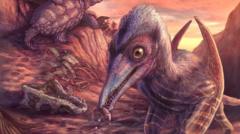Teeth marks on a fossilized leg bone suggest that a terror bird was likely killed by a massive caiman, providing insights into an ancient food chain and predator-prey dynamics.
Ancient Encounter: 'Terror Bird' Killed by Prehistoric Reptile

Ancient Encounter: 'Terror Bird' Killed by Prehistoric Reptile
Discovery reveals a dramatic clash between two apex predators 13 million years ago in Colombia's Tatacoa Desert.
In a remarkable discovery, researchers have unveiled evidence suggesting that a formidable 'terror bird', a top predator from 13 million years ago, met its demise at the jaws of an even larger reptilian foe. The analysis of teeth markings on a fossilized leg bone indicates a violent interaction between the bird and a crocodile-like predator known as a caiman.
Terror birds, towering avians often exceeding human height, were equipped with powerful legs and formidable beaks designed for hunting. The recent study, published in the journal Biology Letters, illustrates how scientists in Colombia matched the distinct teeth markings found on this leg bone, first uncovered in the Tatacoa Desert more than 15 years ago, to the characteristics of the caiman species, Purussaurus neivensis.
Utilizing advanced 3D digital scans, researchers compared the size and shape of the bite marks with fossilized skulls and teeth from available museum collections. This approach provided invaluable insight into the dynamics of predator interactions during the Middle Miocene epoch, a period characterized by humid swampy conditions, which allowed for the preservation of exceptional fossil remains.
Lead researcher Andres Link, affiliated with the Universidad de Los Andes in Bogotá, noted that the evident lack of healing in the bite marks strongly suggests that the terror bird did not survive the encounter. “If it wasn't already dead, it died in the attack,” he explained, capturing the moment of a prehistoric struggle that ultimately led to the bird's extinction.
The fossil, discovered by local collector César Augusto Perdomo, is part of a rich trove of ancient remains buried in the Tatacoa Desert. The analysis marked a significant moment in understanding the predatory behavior and vulnerabilities of terror birds, previously thought to be superior hunters without fear of rivals.
“This analysis reveals that terror birds were possibly more susceptible to predation than we initially understood,” Dr. Link commented, indicating an unexpected complexity in the ancient food web. Such discoveries illustrate the evolving narratives of life on Earth, emphasizing the significance of even the smallest fossil fragments in piecing together the history of prehistoric ecosystems.
The research enriches our understanding of how these apex predators interacted within their environment, offering a glimpse into past ecological balances that have long been lost to time.


















